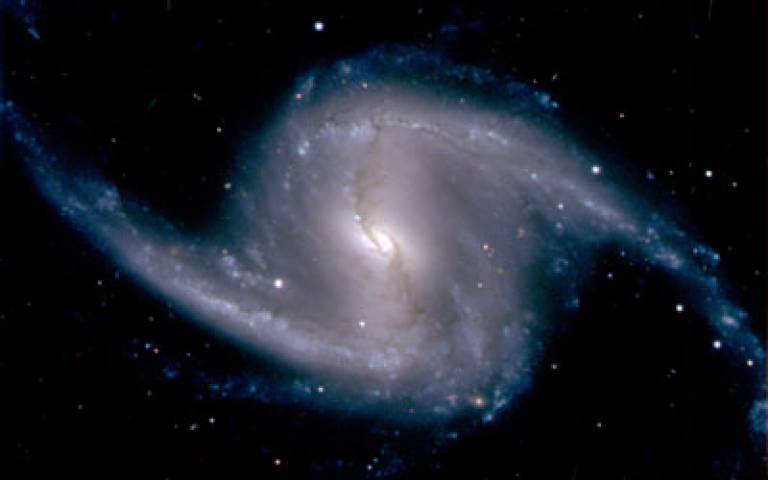Dark energy camera records first images
17 September 2012
Eight billion years ago, rays of light from distant galaxies began their long journey to Earth.
 On 12 September, that
ancient starlight found its way to a mountaintop in Chile, where the
newly-constructed Dark Energy Camera, the most powerful sky-mapping machine
ever created, captured and recorded it for the first time.
On 12 September, that
ancient starlight found its way to a mountaintop in Chile, where the
newly-constructed Dark Energy Camera, the most powerful sky-mapping machine
ever created, captured and recorded it for the first time.
That light may hold within it the answer to one of the biggest mysteries in physics - why the expansion of the universe is speeding up.
Scientists on the Dark Energy Survey (DES) collaboration announced this week that the Dark Energy Camera, the product of eight years of planning and construction by scientists, engineers, and technicians on three continents, has achieved first light. The first pictures of the southern sky were taken by the 570-megapixel camera on 12 September.
UK astronomers are key players in the DES collaboration, which is led by Fermilab in the US. The UK consortium comprises UCL (University College London), Portsmouth, Cambridge, Edinburgh, Sussex and Nottingham. The construction of the DES Camera was partially supported by UK's STFC.
The optical corrector, a major component of the camera, was put together at UCL and has taken several years to complete. It was shipped form London to the telescope in Chile in December 2011.
The assembly of five lenses for the DES Camera and its installation on the telescope is a major technological achievement, producing one of the largest cameras on the globe.
Dr Peter Doel (UCL Physics & Astronomy)
Dr Peter Doel of UCL's Optical Science Laboratory (UCL Physics & Astronomy) said: "The assembly of five lenses for the DES Camera and its installation on the telescope is a major technological achievement, producing one of the largest cameras on the globe."
Professor Ofer Lahav, from UCL, who heads the DES:UK Consortium and the DES Science Committee commented: "The achievement of first light through the Dark Energy Camera brings us a step closer to understanding dark energy, one of the biggest mysteries in the whole of physics. The deep observations with the DES camera will tell us why the universe is speeding up and if a major shift is required in our understanding of the universe."
The Dark Energy Camera, which is roughly the size of a phone booth, is the most powerful survey instrument of its kind, able to see light from over 100,000 galaxies up to 8 billion light years away in each snapshot. The camera's array of 62 charged-coupled devices have an unprecedented sensitivity to very red light, and along with the Blanco telescope's large light-gathering mirror (which spans 13 feet across), will allow scientists from around the world to pursue investigations ranging from studies of asteroids in our own Solar System to the understanding of the origins and the fate of the universe.
Scientists in the Dark Energy Survey collaboration will use the new camera to carry out the largest galaxy survey ever undertaken, and will use that data to carry out four probes of dark energy, studying galaxy clusters, supernovae, the large-scale clumping of galaxies, and weak gravitational lensing. This will be the first time all four of these methods will be possible in a single experiment.
Dr. Sarah Bridle (UCL Physics & Astronomy) who co-coordinates the weak lensing studies of DES commented: "This will be the largest galaxy survey of its kind, and the 300 million galaxy shapes and positions will allow us to map the Dark Matter at different times in the history of the Universe, from which we can learn about the nature of Dark Energy."
Dr. Filipe Abdalla (UCL Physics & Astronomy), who co-coordinates spectroscopic data for DES added: "The construction of a 3-dimensional map of the galaxies just based on their angular coordinates their colours is a challenge which requires novel approaches. Additional spectroscopic data will greatly improve the accuracy of the map".
The Dark Energy Survey is expected to begin in December, after the camera is fully tested, and will take advantage of the excellent atmospheric conditions in the Chilean Andes to deliver pictures with the sharpest resolution seen in such a wide-field astronomy survey.
Over five years, the survey will create detailed colour images of one-eighth of the sky, or 5,000 square degrees, to discover and measure 300 million galaxies, 100,000 galaxy clusters, and 4,000 supernovae.
In addition to STFC's contribution, DES is
supported by funding from the U.S. Department of Energy; the National Science
Foundation; and funding agencies in Spain,
Brazil, Germany, and Switzerland; and the participating
DES institutions.
Image: Zoomed-in image from the Dark Energy Camera of the barred spiral galaxy NGC 1365, in the Fornax cluster of galaxies, which lies about 60 million light years from Earth. Credit: Dark Energy Survey Collaboration.
 Close
Close

